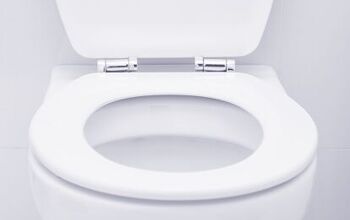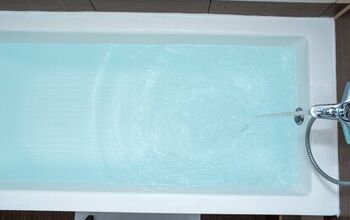Why Is My Toilet Water Grey? (Find Out Now!)

Bathrooms and lavatories have never been synonymous with cleanliness, but we do expect and want them to be clean. So when we find that unwanted, always unwelcome, and quite frankly, unsightly grey toilet water, questions arise. First and foremost, is why is my toilet water grey, most often and quickly followed by the question, what can I do about it.
The most common reasons for grey toilet water are hard water, bacteria, calcium, and other possible culprits. It can also be a result of unhygienic practices. Additionally, this can cause sulfur bacteria, which is what leaves that gray stain in your toilet. A thorough and regular cleaning process, however, can eliminate this problem.
As unnatural and unattractive as it looks, grey water in the toilet is more often than not the result of natural causes. This, of course, doesn’t apply to the unnatural cause of poor hygienic practices. While there may not be much that can be done about the former, there is an answer for the first issue.
The problem of grey water isn’t a new one. It is also an issue that has plagued homeowners, tenants, and toilet owners for years. The good news is there is a solution and one that will work for as long as you own (or use) that toilet. First things first, though, like answering that question, why is my toilet water grey?
Do You Need to Hire a Plumber?
Get free, zero-commitment quotes from pro contractors near you.

The Causes of Grey Toilet Water
There are many technical explanations for grey water appearing in a toilet. And there are the very layman reasons which are also likely (and unfortunately) what you might expect. While experts commonly refer to grey water as domestic wastewater, most of us just call it dirty, and we aren’t wrong either.
To put it mildly, grey water is typically referring to dirty water from various sources (showers, sinks, toilets), minus the fecal contamination. Okay, you can breathe now, but there is more unsavory news to come.
That means that the greatest majority of grey water in our toilets is the result of hard water, bacteria, calcium, and other residues. Unfortunately, some of those residues can also mean trace elements of fecal contaminants, and that leads us to the next question. And sometimes with some urgency and expediency.
How to Clean and Remove Grey Water from Toilet
The cleaning process will remove grey water, disinfect the toilet, fight against the return of grey water, and can be done by anyone. These are the steps to clean and remove grey water from your toilet.
What you will need:
- New toilet brush
- Bleach
- Cleaning gloves (advised)
- Eye protection (optional)
Step 1: Dry Scrub Toilet and Rim
The usual suspects for grey water in the toilet will most often be hiding beneath the rim of the toilet. That is also the area that is going to get the focus and majority of attention during the cleaning process.
If you have eyewear to protect your eyes from backsplash or from getting struck by particles or debris, then put them on along with your protective gloves. The toilet should be left sitting unused long enough to allow the majority of any obvious water remnants to dry.
Using the scrub brush, clean the toilet beginning with an aggressive scrubbing of the aforementioned area beneath the rim. Don’t worry about being too perfect on the first scrub, we just want to use enough force and effort to loosen any of those usual suspects.
Once the entire inside the toilet bowl and rim have been vigorously scrubbed, flush the toilet at least a few times. Allow the commode to fill entirely after each flush.
Step 2: Bleaching the Toilet Rim
The next step is to add bleach to the cleaning process, again with the attention and focus of the cleaning being primarily on the area beneath the rim. Pour about 1/2 cup of bleach into a bleach safe container, and using the scrub brush spread the bleach around the rim of the toilet.
As the bleach is being applied, use a gentle scrubbing motion to help work the bleach in. Finish by pouring the remaining bleach into the toilet bowl. Now, allow the bleach to sit for 30 minutes.
Step 3: Final Bleaching
More than likely there is also a gray stain around the bowl of the toilet too if grey water has been present. Using another 1/2 cup of bleach, pour into and around the toilet bowl.
Gently work the bleach around the toilet bowl using a gentle scrubbing motion with the scrub brush. Allow the bleach to sit for another 15 minutes to work.
Step 4: Final Scrub
Finally, it is time to do a final scrub and reclaim your clean grey and stain-free toilet. Simply flush the toilet a couple of times to remove the remaining beach from the bowl.
Next, briskly scrub the entire toilet, giving about 10-minutes for each section, including the brim, bowl, and neck areas. A couple of flushes when finished and your toilet is now ready to go.
It should also be cited here that after the cleaning process and removal of the grey water problem, the brushes should then be disregarded. A new scrub brush should be used every time the toiled is treated to avoid the risk of carrying any contamination over from earlier cleanings.
Is There A Way To Permanently Treat Grey Water?
Although the cleaning process isn’t terribly difficult, it will likely need to be maintained on a monthly or semi-regular basis. The only other solution is generally neither viable nor practical for most people or households.
There is, however, a more permanent solution for handling and treating grey water in the toilet. Those solutions are known as grey water treatment systems, and they are rather expensive to install and get set up. In addition to the cost of setup, it can also be a rather expensive endeavor to operate these grey water treatment systems.
Does Grey Water Pose Any Health Risks?
It is not only unsightly, unwanted, and unwelcome, grey water in the toilet isn’t necessarily safe either. Although there is no need to sound any alarms at the discovery of grey water in the toilet, it should be addressed sooner than later.
While grey water isn’t generally considered “deadly” that doesn’t make it safe either. Grey water in the toilet can pose health risks as it always can potentially have the ability to carry viruses and bacteria.
In some instances, grey water can also be the springboard for initiating and helping viruses to become airborne. Call a plumber if your toilet water is brown when flushing.
How Often Does The Toilet Need To Be Treated?
This cleaning process to remove grey toilet water is not only effective but will also last for about four weeks. That means that about once every month the toilet should be cleaned using this grey water removal treatment process.
In addition to removing grey water, there are also other common questions that arise during this cleaning process or when faced with the grey toilet water dilemma. Here are a few of those questions along with what you might want or need to know.
Related Questions
Is the bleach used in this cleaning process harmful? Can it sit too long? Does grey water in my toilet pose any health risks? These are a few of the more common questions people have asked when dealing with or facing the issue of grey water in the toilet. Find out what you need to do if your toilet water is blue.
Can Bleach Cause Damage To Toilet Or Plumbing?It is always advisable and suggested to use natural or non-corrosive products when cleaning your toilet. In particular, because of the potential risk of causing harm to the internal plumbing and mechanisms.
The good news is that bleach has proven to provide a safe and effective method for cleaning and removing issues like grey water, mold, and other dirty buildups in toilets.
Can I Leave The Bleach In The Toilet Too Long?As the cleaning process for removing grey toilet water instructs, the bleach should be left in for at least 15 to 30-minutes to allow it to work. Fortunately, although the bleach will have completed its process, it won’t harm or impede the cleaning process if left in the toilet for too long.
What Is Recycled Grey Water?Yes, it does sound rather awful, but rest assured it isn’t nearly as bad as it sounds. The process of recycling water, especially in larger metro areas, for services such as toilet flushing or irrigation purposes has proven to be a smart and effective solution.
Yes, the recycled water is treated, and yes it is safe for many uses – although drinking isn’t one of them. Recycling water also saves a considerable amount of water waste and is a more affordable water solution too.
Do You Need to Hire a Plumber?
Get free, zero-commitment quotes from pro contractors near you.

Summary
Every person and every home deserves to have a clean, safe, and even well-decorated bathroom. Sometimes, that might require some maintenance or treatment, but the benefits are worth the effort. Don’t panic if you see grey water in your toilet, there is a way to deal with it, and a way to regain control of your bathroom too.
Related Guide

We are a team of passionate homeowners, home improvement pros, and DIY enthusiasts who enjoy sharing home improvement, housekeeping, decorating, and more with other homeowners! Whether you're looking for a step-by-step guide on fixing an appliance or the cost of installing a fence, we've here to help.
More by Upgraded Home Team
















![Cost To Drill A Well [Pricing Per Foot & Cost By State]](https://cdn-fastly.upgradedhome.com/media/2023/07/31/9074980/cost-to-drill-a-well-pricing-per-foot-cost-by-state.jpg?size=350x220)










